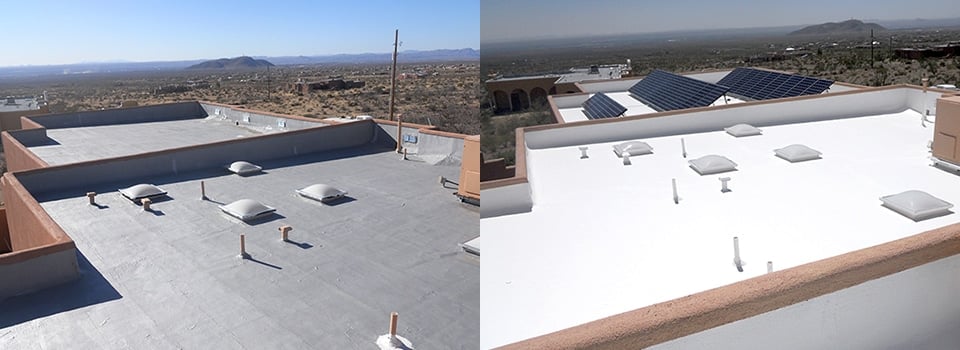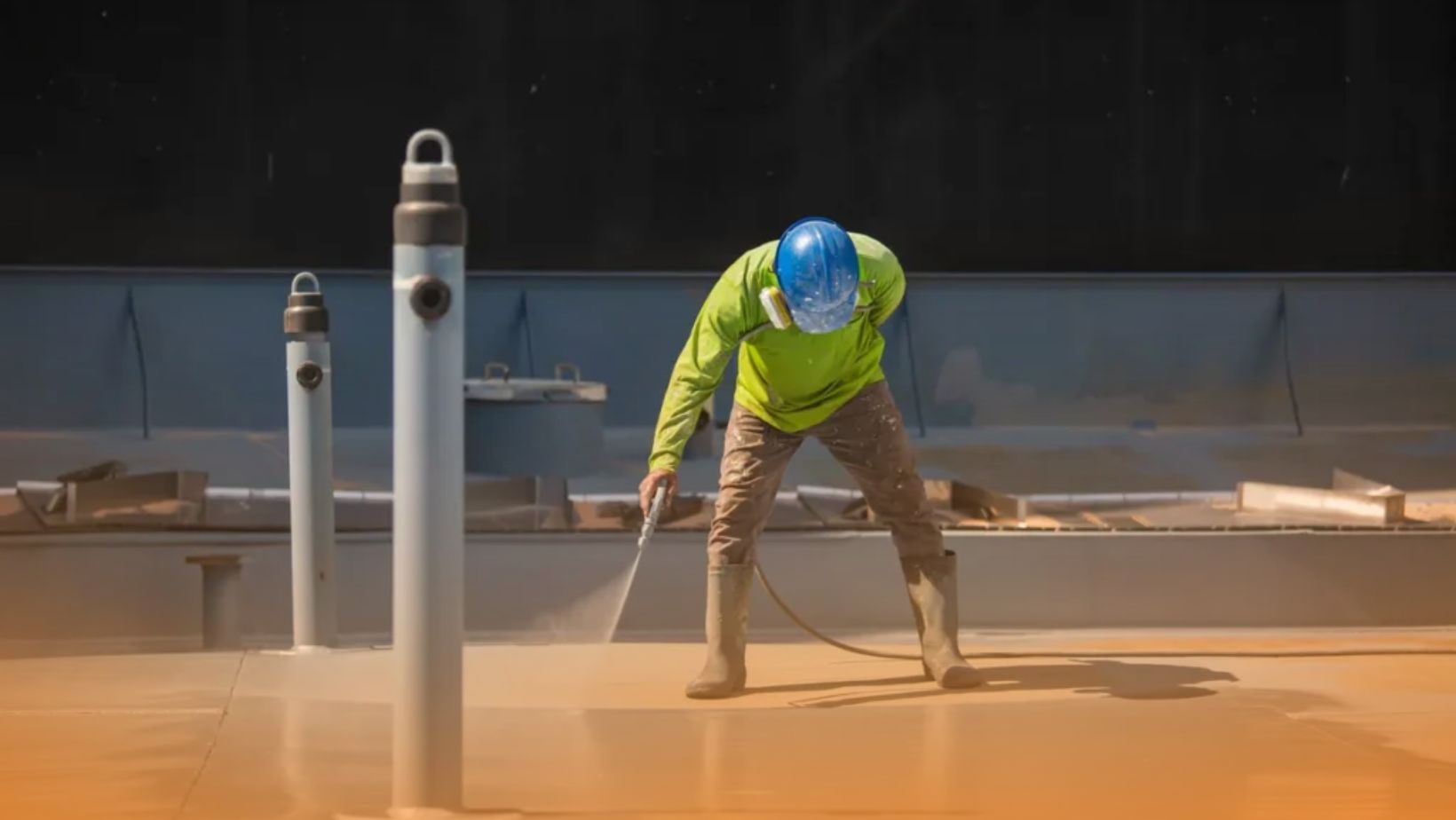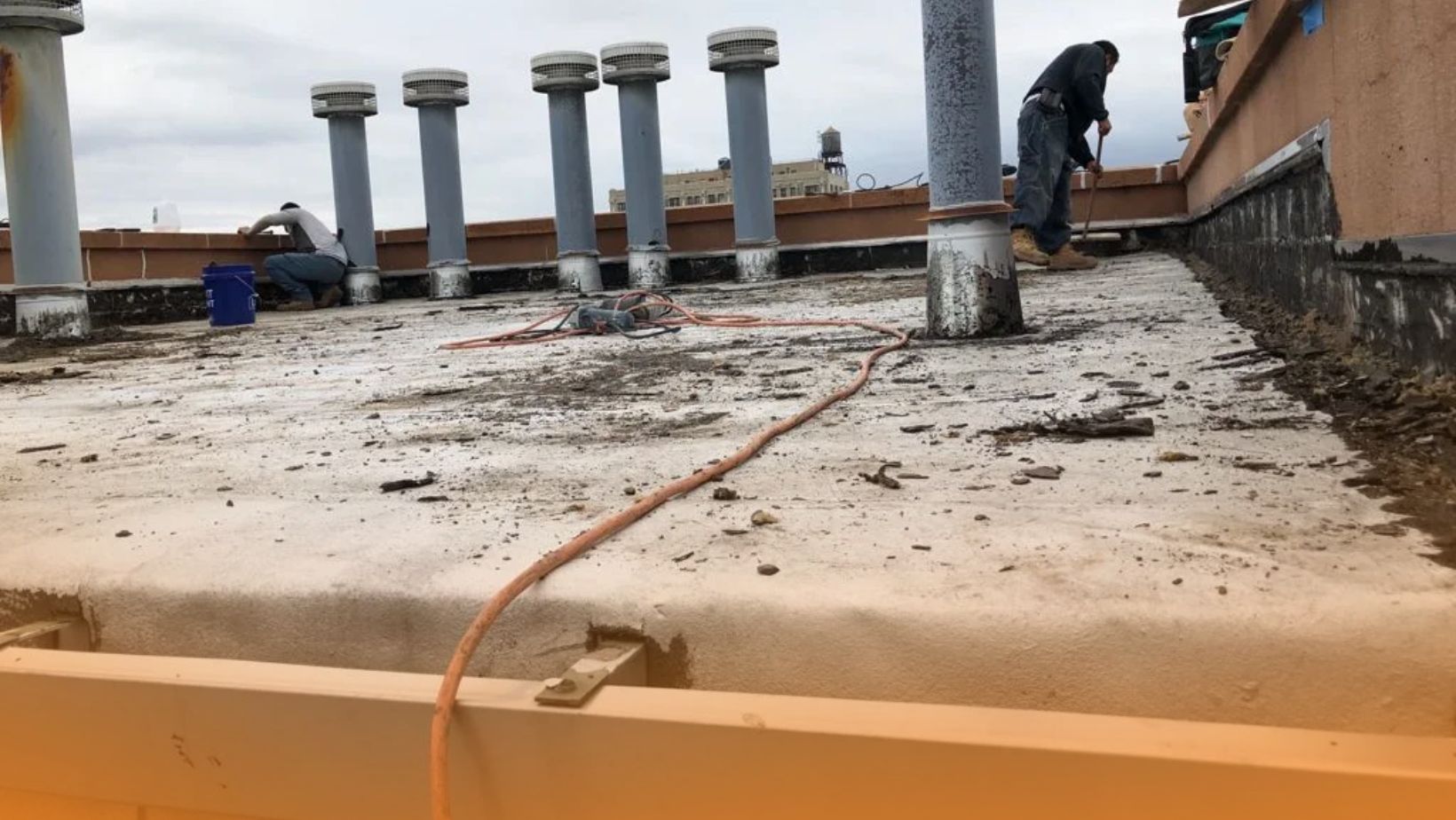Looking for the best reflective roof coatings to save energy and reduce costs? SmartSeal has you covered! Reflective roof coatings are a game-changer when it comes to lowering the surface temperature of your roof, resulting in significant energy savings. These coatings, such as cool roofs, offer numerous benefits, from keeping your building cooler on hot days to extending the lifespan of your roof materials. Let us guide you through everything you need to know about the best roof coatings for energy savings and their incredible benefits.
Key Takeaways:
- Reflective roof coatings, like cool roofs, help lower the surface temperature of your roof, leading to energy savings.
- They can keep buildings cooler, reduce air conditioning costs, and lower greenhouse gas emissions.
- Choosing the right roof type and material is essential for maximizing the benefits of reflective roof coatings.
- Cool roofs have high solar reflectance and high thermal emittance, reflecting sunlight and emitting heat.
- Energy savings with cool roofs vary based on climate and roof insulation.
What are Cool Roofs?
Cool roofs are innovative roofing solutions designed to reflect sunlight and emit heat, keeping the roof surface temperature cooler compared to traditional roofs. This unique feature helps to reduce heat transfer into the building, leading to energy savings and a more comfortable indoor environment. Cool roofs achieve their exceptional performance through a combination of high solar reflectance and high thermal emittance.
High solar reflectance refers to the ability of a roof to reflect away sunlight rather than absorbing it. By reflecting a larger percentage of sunlight, cool roofs minimize heat absorption, which reduces the amount of heat transferred into the building. Lighter colored roofs, such as white or light gray, generally have the best solar reflectance.
High thermal emittance, on the other hand, refers to the roof’s ability to release heat. Cool roofs are engineered to emit a significant amount of the heat they absorb, decreasing the overall temperature of the roof surface. This helps to keep the building cooler, reduces the need for air conditioning, and lowers energy consumption.
Cool roof principles can also be applied to exterior building walls. By using reflective coatings or materials on building walls, heat absorption can be limited, further contributing to energy savings and improved thermal comfort inside the building.
Benefits of Cool Roofs
- Energy savings through reduced cooling costs
- Improved indoor comfort and temperature regulation
- Extended lifespan of roofing materials
- Reduction in greenhouse gas emissions
- Contribution to mitigating the urban heat island effect
Benefits of Cool Roofs
Cool roofs offer several benefits for both building owners and the environment. Our cool roofs help improve indoor comfort and safety by keeping buildings cooler on hot days. By reducing the need for air conditioning, cool roofs also lower energy costs and reduce the strain on the electrical grid during peak energy demands.
Additionally, cool roofs contribute to reducing pollution and greenhouse gas emissions associated with building energy use. They can also extend the life of the roof materials by decreasing roof temperature, resulting in potential cost savings for building owners. Furthermore, our cool roofs help lower temperatures in the surrounding air, which helps mitigate the urban heat island effect in cities.
Here are the key benefits of cool roofs:
- Improved indoor comfort and safety
- Lower energy costs
- Reduced strain on the electrical grid
- Reduced pollution and greenhouse gas emissions
- Extended lifespan of roof materials
- Mitigation of the urban heat island effect
Implementing cool roofs not only provides tangible benefits for building owners but also contributes to a more sustainable and environmentally friendly future.
Energy Savings with Cool Roofs
The energy savings achieved with cool roofs can have a significant impact on your overall energy consumption, depending on the climate and the level of roof insulation. Cool roofs are particularly effective in hot sunny climates, such as the Southern United States, where they can save more energy by reducing the amount of heat transferred into the building.
Imagine a typical summer afternoon: a clean white roof that reflects 80% of sunlight can stay about 50°F cooler than a grey roof that reflects only 20% of sunlight. This temperature difference can make a substantial difference in cooling needs and energy usage for air conditioning.
In Northern climates, where the climate is cooler, energy savings for buildings with cool roofs are still significant and are predicted to grow as the climate warms. Even in milder climates, the sun’s heat can still impact buildings, and cool roofs can help mitigate that effect, reducing the need for cooling and saving energy.
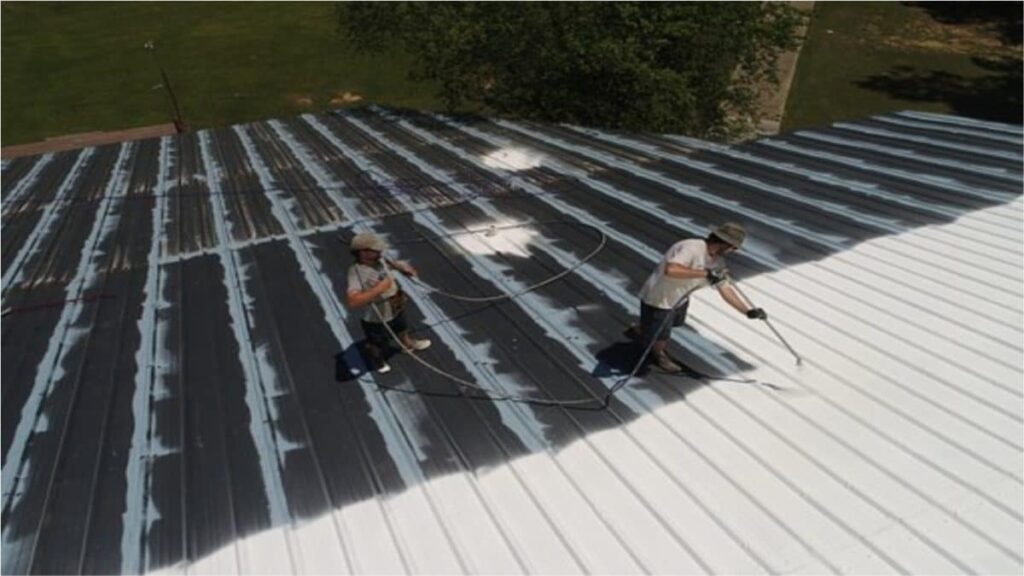
The following table presents a comparison of energy savings achieved with cool roofs in different climates:
| Climate | Energy Savings with Cool Roofs |
|---|---|
| Hot Sunny Climates | Significant energy savings due to lower cooling needs. |
| Mild to Moderate Climates | Reduced energy consumption for cooling, though savings may be less compared to hot sunny climates. |
| Northern Climates | Energy savings are still significant and predicted to increase as the climate warms. |
Types of Cool Roofs
Cool roofs are a versatile option that can be installed on both sloped and low-sloped roofs, providing energy-saving benefits and improving indoor comfort. Let’s explore the different types of cool roofs and the roofing materials used for each.
Cool Roofs for Sloped Roofs
Sloped roofs, characterized by a pitch greater than 2:12 (9.5 degrees from horizontal), can be made cool using various roofing materials. These materials have high solar reflectance, allowing them to reflect away sunlight and reduce heat absorption. Some common cool roof options for sloped roofs include:
- Membranes
- Shingles
- Coatings
- Stone/Rock
- Metal
- Tile with high solar reflectance
These materials are available in different colors and styles while offering the benefits of cool roofs, such as energy savings and extended roof lifespan.
Cool Roofs for Low-Sloped Roofs
Low-sloped roofs, with a pitch less than or equal to 2:12, also have cool roof options suitable for their design. These options employ specific roofing materials that enhance solar reflectance and thermal emittance. Some cool roof choices for low-sloped roofs include:
- Single-ply membranes
- Built-up roofs
- Modified bitumen sheet membranes
- Spray polyurethane foam roofs
These materials help regulate roof temperature, reduce heat transfer, and provide energy-efficient solutions for low-sloped roofs.
Green Roofs as Cool Roofs
In addition to the traditional cool roof materials, green roofs are another eco-friendly option that can act as cool roofs. Green roofs, also known as vegetative roofs, are designed with a layer of vegetation, providing environmental benefits such as managing stormwater runoff, reducing urban heat island effect, and creating a visually pleasing rooftop space.
| Cool Roof Type | Roof Pitch | Examples of Roofing Materials |
|---|---|---|
| Sloped Roofs | Pitch greater than 2:12 | Membranes, shingles, coatings, stone/rock, metal, tile |
| Low-Sloped Roofs | Pitch less than or equal to 2:12 | Single-ply membranes, built-up roofs, modified bitumen sheet membranes, spray polyurethane foam roofs |
| Green Roofs | Varies | Vegetation |
By considering the roof pitch and utilizing suitable roofing materials, any type of roof can be transformed into a cool roof, providing energy efficiency and sustainability benefits.
Selecting the Right Cool Roof
When it comes to choosing a cool roof, it’s essential to consider both the type of roof and the specific product that best suits your needs. Fortunately, the Cool Roof Rating Council (CRRC) is an invaluable resource that provides valuable information on different roof types and product types with high solar reflectance and thermal emittance.
The CRRC offers a wide range of cool roof materials to choose from, including:
- Light-colored or cool-colored asphalt shingles
- Wood shingles and shakes
- Polymer shingles
- Clay and concrete tiles
- Metal shingles or tiles
- Various membranes
Besides these common cool roof options, you can also consider ballasted roofing and green roofs as effective cool roof strategies. The CRRC maintains an extensive online database of cool roof products, making it easy to find the right product for your project.
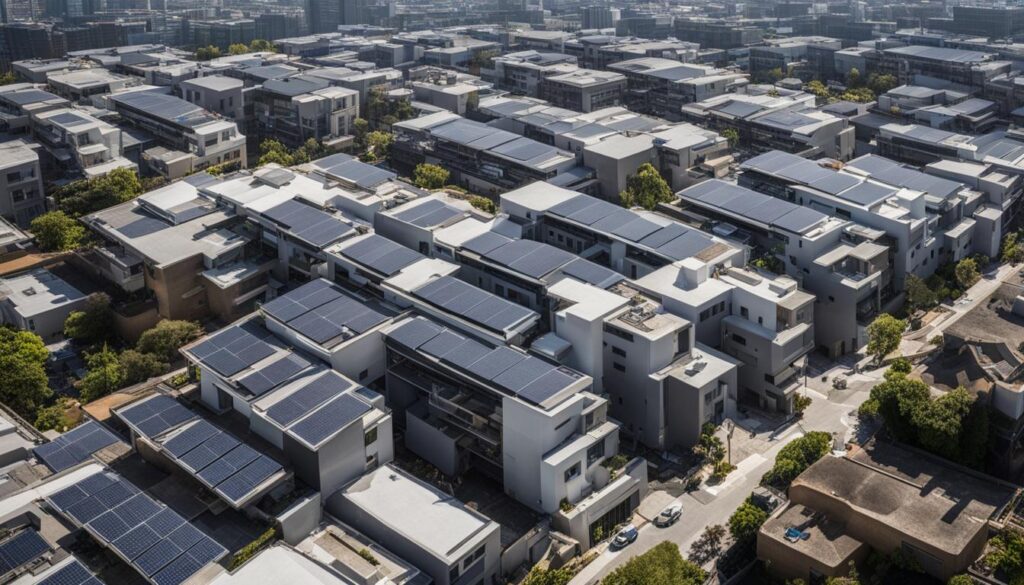
| Cool Roof Material | Solar Reflectance | Thermal Emittance |
|---|---|---|
| Light-colored asphalt shingles | 0.30 – 0.50 | 0.80 – 0.90 |
| Wood shingles and shakes | 0.20 – 0.30 | 0.80 – 0.90 |
| Polymer shingles | 0.30 – 0.60 | 0.80 – 0.90 |
| Clay and concrete tiles | 0.30 – 0.40 | 0.70 – 0.90 |
| Metal shingles or tiles | 0.30 – 0.60 | 0.70 – 0.90 |
| Various membranes | 0.40 – 0.80 | 0.70 – 0.90 |
Incentives, Codes, and Standards
When it comes to adopting cool roofs, homeowners and businesses may be eligible for incentives such as rebates and loans in certain locations. These incentives aim to encourage the implementation of cool roofs and promote energy efficiency. Additionally, green building programs may offer credits for utilizing cool roofs, further incentivizing their adoption. It is important to take advantage of these opportunities to reduce costs and contribute to a more sustainable environment.
Moreover, specific locations may have codes or standards that require the use of cool roofs in new construction and re-roofing projects. These codes and standards ensure that buildings meet energy efficiency requirements and contribute to reducing the environmental impact. To comply with these regulations, it is crucial to familiarize yourself with local authorities and consult the Cool Roof Rating Council (CRRC) website for detailed information on incentives, programs, and requirements.
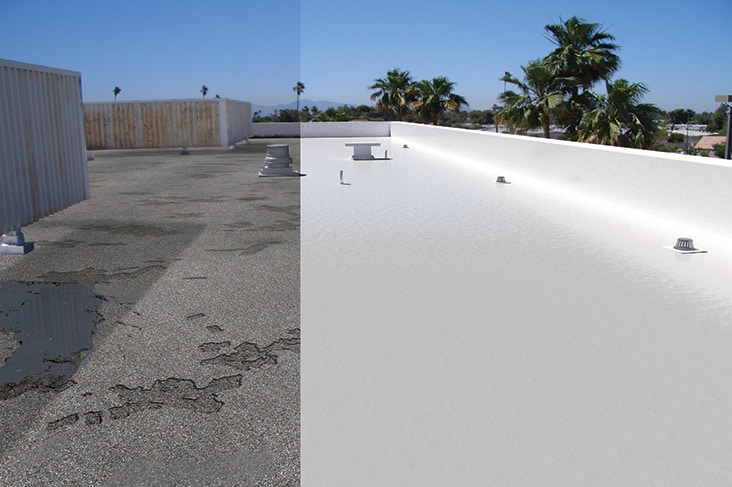
“By utilizing cool roofs, homeowners and businesses not only save on energy costs but also contribute to a greener future.”
How to Make a Roof Cool
There are different ways to make a roof cool. Choosing a cool covering during new construction or roof replacement is the easiest and least expensive method. Cool colored products, which reflect about 30-60% of sunlight, can be used to boost the solar reflectance of dark materials.
“Choosing a cool covering during new construction or roof replacement is the easiest and least expensive method.”
Another option is to retrofit existing roofs with cool coatings, although this may incur additional material and labor costs. White roofing products are the coolest in the sun, reflecting about 60-90% of sunlight, while cool colored products can offer a cooler alternative to conventionally colored products.
Cool Roof Options
Here are some cool roof options to consider:
| Cool Roof Option | Description |
|---|---|
| White Roofing | White roofing products have high solar reflectance and offer excellent heat reflection properties. |
| Cool Colored Products | Cool colored products, available in a range of shades, provide a cooler alternative to conventionally colored products. |
| Cool Coatings | Cool roof coatings can be applied to existing roofs to enhance their solar reflectance and reduce heat absorption. |
By choosing these cool roof options, you can significantly lower the temperature of your roof and create a more energy-efficient environment.
Radiant Barrier Roof Coatings
Radiant barrier roof coatings, such as LO/MIT-I, offer an effective solution for property owners looking to conserve energy and enhance heat reflection. These specialized coatings are formulated to effectively reduce the surface temperatures of roofs, providing a low-cost option for energy preservation. LO/MIT-I, a silver-colored, low emissivity paint, can be easily applied to various roofing substrates, helping to control interior temperatures and decrease air conditioning loads. By minimizing heat-related stress on roofing materials, LO/MIT-I improves overall comfort while reducing energy consumption.
With its thin coat application, LO/MIT-I can be conveniently applied using either airless spray or rollers, ensuring a straightforward installation process. This radiant barrier roof coating is also ENERGY STAR certified, meeting rigorous standards for energy efficiency. LO/MIT-I has been a trusted and proven energy-saving product since 1986, making it a reliable choice for property owners seeking improved energy conservation and heat reflection.
Conclusion
Reflective roof coatings, such as cool roofs and radiant barrier coatings like LO/MIT-I, offer significant energy savings and environmental benefits. By reducing roof surface temperatures and minimizing heat transfer into buildings, these coatings help lower cooling costs, reduce the strain on the electrical grid, and lower greenhouse gas emissions.
Additionally, cool roofs contribute to improving indoor comfort, extending the life of roof materials, and mitigating the urban heat island effect. The use of reflective roof coatings helps keep buildings cooler on hot days, reducing the need for air conditioning and lowering energy consumption. This not only translates into cost savings for building owners but also has a positive impact on the environment by reducing carbon emissions.
Choosing the right cool roof option is crucial for maximizing the benefits of reflective roof coatings. It is important to consider factors such as roof type, product type, and local incentives and regulations. By selecting the appropriate cool roof solution, building owners can optimize energy savings, enhance indoor comfort, and contribute to a more sustainable future.
Contact the top Sanford commercial roof coating experts today to get started on your commercial building.
FAQs
What are reflective roof coatings?
Reflective roof coatings are a type of coating that can lower the surface temperature of a roof, reducing heat transfer into a building and leading to energy savings. Cool roofs are an example of reflective roof coatings, designed to reflect sunlight and emit heat.
What are the benefits of cool roofs?
Cool roofs offer several benefits, including improving indoor comfort, reducing air conditioning costs, lowering greenhouse gas emissions, extending the life of roof materials, and mitigating the urban heat island effect in cities.
How do cool roofs save energy?
The energy savings achieved with cool roofs vary depending on the climate and level of roof insulation. In hot sunny climates, cool roofs can save more energy. On a typical summer afternoon, a clean white roof that reflects 80% of sunlight can stay about 50°F cooler than a grey roof that reflects only 20% of sunlight.
What types of roofs can be made cool?
Both sloped and low-sloped roofs can be made cool. Sloped roofs can be made cool with various materials such as membranes, shingles, coatings, stone/rock, metal, and tile with high solar reflectance. Low-sloped roofs can be made cool with single-ply membranes, built-up roofs, modified bitumen sheet membranes, and spray polyurethane foam roofs.
How do I select the right cool roof?
When selecting a cool roof, it is important to consider the type of roof and the product type that best suits your needs. The Cool Roof Rating Council (CRRC) provides valuable information on different roof types and product types that have high solar reflectance and thermal emittance. They also maintain an extensive online database of cool roof products for easy product search.
What incentives are available for cool roofs?
There may be rebates, loans, and credits available for homeowners and businesses in certain locations to encourage the adoption of cool roofs. Some green building programs also offer credit for using cool roofs. It is important to check with local authorities and the CRRC website for information on these incentives, programs, and requirements.
How can I make my roof cool?
There are different ways to make a roof cool. Choosing a cool covering during new construction or roof replacement is the easiest and least expensive method. Cool colored products can be used to boost the solar reflectance of dark materials. Another option is to retrofit existing roofs with cool coatings, although this may incur additional material and labor costs.
What is LO/MIT-I radiant barrier roof coating?
LO/MIT-I is a silver-colored, low emissivity paint that can be applied to a wide range of roofing substrates. It helps control interior temperatures, lower air conditioning loads, increase comfort, and reduce heat-related stress on roofing materials. LO/MIT-I is also ENERGY STAR certified and has been proven as an energy-saving product since 1986.
What are the benefits of LO/MIT-I roof coating?
LO/MIT-I offers several unique qualities that make it a popular choice for reflective roof coatings. It has a low applied cost compared to other coatings, provides rapid payback for energy conservation, lowers roof skin temperature by 20°F-50°F, and greatly improves interior comfort levels. LO/MIT-I is also flexible, adheres to various roofing materials, and does not require a primer in most cases.
Are there any testimonials or case studies for LO/MIT-I roof coating?
Users of LO/MIT-I have reported positive experiences with the product, highlighting its effectiveness in reducing roof surface temperatures and improving energy efficiency. Testimonials include significant temperature reductions on rubber roofs, increased reflectivity on metal roofs, and noticeable savings on electric bills for built-up roofs. LO/MIT-I has been tested and proven to be an energy-saving product since 1986.
What are the environmental benefits of reflective roof coatings?
Reflective roof coatings, such as cool roofs and radiant barrier coatings like LO/MIT-I, offer significant energy savings and environmental benefits. By reducing roof surface temperatures and minimizing heat transfer into buildings, these coatings help lower cooling costs, reduce the strain on the electrical grid, and lower greenhouse gas emissions. They also contribute to improving indoor comfort, extending the life of roof materials, and mitigating the urban heat island effect.

